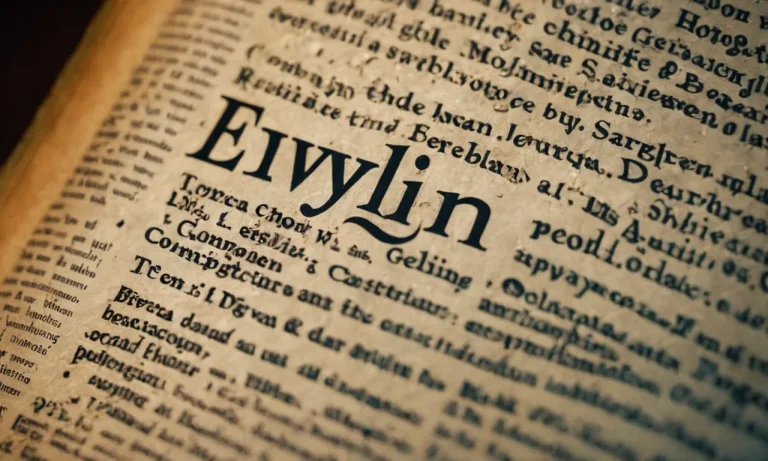Who Is Veronica In The Bible?
The name Veronica appears nowhere in the Bible, yet she has become an intriguing biblical figure over the centuries. If you’re short on time, here’s a quick answer to your question: Veronica is known as the woman who wiped Jesus’ face with a cloth as he carried his cross to Calvary, according to Catholic tradition.
The cloth then bore the image of his face.
In this comprehensive article, we’ll explore the legend of Saint Veronica and how she became an important figure in Catholicism despite her story never appearing in scripture.
We’ll look at the biblical roots of her tale, the relic known as the Veil of Veronica, her role in the Stations of the Cross, and how artists have depicted her compassionate act over the years.
The Legend of Saint Veronica
Veronica Wipes Jesus’ Face
According to Christian tradition, Veronica was a woman from Jerusalem who had an encounter with Jesus along the Via Dolorosa on the way to Calvary.
As Jesus struggled under the weight of the cross, Veronica saw him and was moved with compassion.
She stepped out of the crowd lining the street and wiped the sweat and blood from Jesus’ face with her veil. The veil then miraculously retained an image of Christ’s face, known as the Veil of Veronica.
This story does not appear in the canonical Gospels, but is a pious tale that emerged in later centuries. The name “Veronica” itself seems to be related to the Latin words vera icon meaning “true image.”
So the story captures the way this woman’s act of compassion left Christ’s true image imprinted on her veil.
Meaning Behind the Name Veronica
As mentioned, the name Veronica likely comes from a Latin phrase meaning “true icon” or “true image.” According to the Catholic Encyclopedia, the word seems to come from the Macedonian Berenice which also means “bringer of victory.”
So Veronica is a name that evokes the woman who wiped Christ’s face in his passion, retaining a true image of him on her veil.
The meanings behind the name also relate to the virtues the legendary Saint Veronica represents – compassion, piety, caring for Christ in his suffering. Her story and name have inspired devotion to Christ’s passion for centuries.
Even if she remains somewhat legendary, Veronica stands for the piety all Christians are called to emulate.
Veronica in the Apocryphal Texts
While the figure of Veronica does not appear in the canonical Bible, references to her emerged in extra-biblical apocryphal literature as early as the 4th century in the Acta Sanctorum.
These texts captureadditional stories and legends about saints not included in the Bible.
Veronica is also mentioned in the text known as the Vindicta Salvatoris dating to the 9th or 10th century. This apocryphal work captures Christ’s words of judgment on those who mistreated him in his passion.
It includes a section where Christ confirms that Veronica’s veil did indeed bear his “triumphant face” as a reward for her compassion and courage in wiping his face.
While she remains somewhat legendary, Veronica’s story has inspired many works of art, literature and devotion related to Christ’s passion over the centuries since these apocryphal tales emerged. She represents the piety all Christians should emulate even in difficult times – caring for Christ by caring for others who suffer.
The Veil of Veronica Relic
Description of the Veil
The Veil of Veronica is a Christian relic believed to be the cloth used by a woman named Veronica to wipe the sweat and blood from the face of Jesus Christ as he carried the cross to Calvary.
According to Christian tradition, Veronica encountered Jesus along the Via Dolorosa and offered him a cloth to wipe his face.
When she received the cloth back, the image of his face was miraculously imprinted upon it. This encounter is commemorated in the sixth Station of the Cross in many Christian traditions.
The relic itself is a piece of cloth or fabric that contains the faint image of a man’s face with eyes closed and a beard.
The facial features are hard to discern clearly. There are at least six images and relics venerated as the Veil of Veronica in different parts of Europe.
The most famous of these is displayed at St. Peter’s Basilica in the Vatican. Millions of pilgrims have traveled to view this relic over the centuries.
While the authenticity of any single Veil of Veronica relic is unprovable, the story has symbolic significance for many Christians. It represents an act of compassion towards Christ in his suffering. It also signifies the way Christ’s face – and message – remains imprinted upon the hearts of those who encounter him.
Veneration and History of the Relic
The Veil of Veronica was widely venerated in the Middle Ages. The Fourth Crusade brought one version of it from Constantinople to Rome in the 13th century. During the 14th century, Dante and Petrarch made references to it in their poetry.
Millions of medieval pilgrims viewed Veronica’s veil in St. Peter’s Basilica. Several popes during the 16th and 17th centuries exhibited the relic publicly in Vatican City.
However, some experts began questioning the Veil’s authenticity. In 1608 Pope Paul V forbid any replica of Veronica’s face to be made.
Scientific analysis in recent centuries, including carbon-dating, has revealed the cloth dates to the Middle Ages rather than the 1st century AD.
Today the Catholic Church makes no pronouncement on the Veil’s authenticity, leaving it a matter of personal religious devotion.
While debate continues on the true origins of the Veil of Veronica, the story of Veronica’s compassion resonates with Christians today. Her act of wiping Jesus’ face reminds believers to show mercy. And the imprint she received signifies how Christ leaves his mark on the lives of those who follow him.

Veronica’s Role in the Stations of the Cross
In the Stations of the Cross, Veronica occupies the sixth station, where she compassionately wipes the face of Jesus as he carries his cross to Calvary. This act of kindness provides comfort to Jesus in his suffering.
According to Catholic tradition, when Veronica wiped Jesus’ face, his image became imprinted on the cloth she used.
This cloth became known as Veronica’s Veil or the Veil of Veronica. The image of the suffering face of Christ came to symbolize Veronica’s compassion and empathy.
Veronica’s act has inspired many over the centuries to show mercy and compassion to those who suffer.
In the Stations of the Cross devotion, Veronica reminds us of our call as Christians to see the face of Christ in those who suffer and reach out to them in their time of need.
Though Veronica is not mentioned in the Bible, she has become an integral figure in Catholic spirituality and art. Depictions of Veronica wiping the face of Jesus are a common scene in cycles of the Passion of Christ in art and literature.
Artistic Depictions of Veronica and Her Veil Over the Centuries
Early Representations
The earliest known artistic depiction of Saint Veronica and her veil dates back to the 6th century. In these early centuries, she was simply referred to as “The Holy Woman” or “The Pious Woman”.
Scenes showing her encountering Jesus on the Via Dolorosa and wiping his face appear in illuminated Gospel Books from this period.
The veil itself is rarely shown in full. Instead, the focus is on Veronica’s gesture of compassion towards Christ. Piety and empathy are emphasized rather than the relic itself.
The Veil in Renaissance and Baroque Art
During the Renaissance, interest in Saint Veronica and her veil expanded greatly. The cloth becomes a central focus of attention in painting and sculpture.
Veronica emerges as an iconic figure. Many striking images depict her holding up the entire veil, with Christ’s face clearly visible.
These renditions highlight the miraculous image as proof of Christ’s suffering and divinity. Symbolic meanings also develop, linking Veronica’s compassion to the Eucharist and Church.
Exquisite examples appear in work by Dürer, Rubens, Velazquez, Van Dyck, and Rembrandt.
The Baroque period sees a further proliferation of Veronica imagery. The remarkable detail and realism of Christ’s face on her veil is emphasized. Veronica is portrayed as pious witness and the veil as tangible evidence of Christ’s sacrifice.
Bernini and Claude Lorrain created some of the most renowned Baroque interpretations. Additionally, the Catholic Church declared the veil a relic equal to the Shroud of Turin.
Contemporary Renderings
Modern artists have continued to be fascinated by Saint Veronica and her veil. Some, like Robert Lentz, have rendered the theme in new styles while respecting tradition. Others have reinterpreted the subject more provocatively.
For example, Ron DiCianni painted Veronica as a contemporary woman offering compassion. The emphasis shifts to timeless themes of empathy, solidarity with suffering, and bearing witness.
Photographers such as Jeffrey Keeten have also found inspiration in Veronica’s veil, exploring ideas of images appearing on cloth. While depictions have changed, Saint Veronica remains a compelling artistic subject over the centuries.
Her act of compassion and the miraculous image on her veil still resonate in the modern world.
Conclusion
While Veronica herself likely never existed, her story has inspired faith and compassion for centuries. As one of the most revered female figures in Catholic tradition, Veronica continues to fascinate both religious devotees and art lovers alike.
Her legendary act of wiping Jesus’ bloodied face endures as a universal symbol of mercy and humanity.








